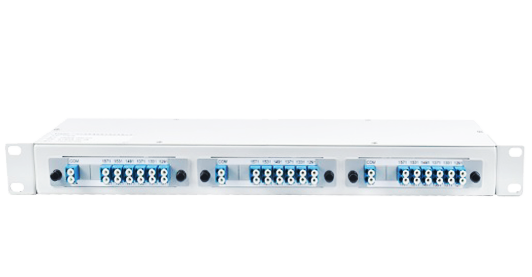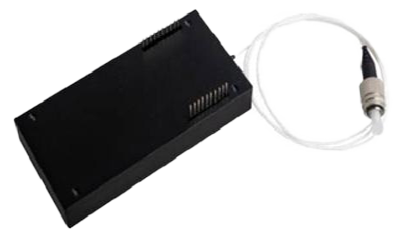As the deployment of wireless networks becomes more and more intensive, the scale of large-capacity distributed base stations is also expanding. The deep coverage of base stations requires the location of the deployment to be closer to users. The passive optical fiber expander introduced by utilizes the characteristics of a single optical fiber that can transmit multiple optical carriers of different wavelengths at the same time. It effectively solves the problem of the lack of optical fiber cable resources between BBU and RRU/DU and AAU in the C-RAN architecture, and meets the requirements for deep coverage and flexible expansion of carrier base stations.
Supporting CWDM/DWDM.
Low insertion loss and high channel isolation.
Supporting upgrade and expansion.
Optical wavelength customization.
High reliability and stability.
Waterproof, dustproof and resistant to high and low temperatures, no power is required.
With the fierce development of 5G communication technology, 5G base stations are being deployed on a large scale, and the deep coverage of base stations requires that the deployment location be closer to users. However, the traditional front-haul solution using fiber optic direct drive between DU and AAU has a series of problems such as tight pipeline resources, high cable cost, long construction period, and difficulty in capacity expansion.Hirundo 5G front-haul semi-active equipment is designed to solve the problems of lack of cable resources, long construction period, and high cost due to the direct drive of the optical cable between DU-AAU in the 5G front-haul under the C-RAN architecture.The device adopts active WDM device on the DU side and a passive wavelength division multiplexer plus colored transceiver module on the AAU side to form a unified management and control front-haul network. It provides PC-side Web and client-side APP network management and high reliability 1+1 protective function. Realize the low-cost, high-reliability and fast deployment of 5G front-haul network construction for operators.
Support CWDM 6 channels, 12 channels or wavelength customization.
Support 1 + 1 optical line protection and real-time monitoring of optical power.
Support the state of the optical line to remain unchanged when power down, without affecting the normal work of the business.
Support automatic and manual working mode and automatic switchback function, the switching time is less than 30ms.
Support Web, APP network management method.
Support local and remote control functions.
Hirudo Passive Optical Fiber Expansion Equipment base station remote product effectively solves the practical problem of lack of fiber-optic cable transmission resources between BBU-RRU/DU-AAU in C-RAN architecture, and meets the requirements of deep coverage and flexible expansion of carrier base stations. Moreover, it can provide multi-solutions for full scene access and end-to-end loading.
Application 1: Passive Solution
Passive solutions need to deploy passive optical fiber expansion equipment between BBU/DU pool and RRU/AAU. Only one pair of optical fibers is required between the passive optical fiber expansion equipment. At the same time, we need to replace the SFP colored optical module provided by our company at the CRU port of RRU/AAU and BBU/DU.

Figure 1: Passive Application Solution for BBU/DU & RRU/AAU
Application 2: Active Solution
Active solutions need to deploy active optical fiber expansion devices between BBU/DU pool and RRU/AAU. Only one pair of optical fibers is required between the active optical fiber expansion devices, and the original BBU/DU devices and RRU/AAU devices do not need to be changed. Plug-and-play, it supports mixed transmission of other types of services.

Figure 2: Active Application Solution for BBU/DU & RRU/AAU
Passive Optical Fiber Expansion Equipment
System Parameter | Technical Index |
Optical fiber expansion capacity | Single fiber bidirectional: The maximum capacity of fiber can be expanded by 9 times. Dual fiber bidirectional: The maximum capacity of fiber can be expanded by 18 times. |
Insertion loss | The insertion loss introduced by the devices at both ends is less than 2~5 (dB); it depends on the capacity expansion. |
Access business type | It can access optical signals including SDH, Ethernet, FC, PON, CPRI and other formats. |
Transmission distance | 0~40KM. |
Operation environment | Working temperature | -10℃ ~ +70℃ or -40℃ ~ +80℃. |
Working humidity | 5%~95%. |
Connector type | LC, FC, SC, etc. (optional) |
Device Dimension | 1U chassis | 438mm (W) ×44mm (H) ×230mm (D). |
Card type | 25mm (W) ×130mm (H) ×100mm (D). |
Card with chassis | 438mm (W) ×132mm (H) ×110mm (D). |
Weight | 1U chassis | ≤5KG. |
Card type | ≤0.2KG. |
Card with chassis | ≤7KG. |
MTBF | 130000 hours. |
5G Front-haul Active Device
System Parameter | Technical Index |
Wavelength range | CWDM: 1271nm ~ 1610nm can be customized |
Fiber type | G.652 G.653 G.655 |
Service access type | Ethernet, CPRI, eCPRI, etc. |
Line side protection method | 1 + 1 protection |
Switching time | <50ms |
Operating mode | Automatic and manual |
Introduction loss | <7dB |
Network management | Web, APP |
Card size | 177 (W) × 20 (H) × 225 (D) (mm) |
2U chassis size | 440 (W) × 88 (H) × 285 (D) (mm) |
4U chassis size | 440 (W) × 176 (H) × 250 (D) (mm) |
Plug-in box size | 129 (W) × 25 (H) × 113 (D) (mm) |
1U chassis size | 483 (W) × 45 (H) × 112 (D) (mm) |
3U chassis size | 129 (W) × 132 (H) × 112 (D) (mm) |
Operation environment | Operating temperature | -10 ℃ ~ 70 ℃ |
Storage temperature | -40 ℃ ~ 80 ℃ |
Relative humidity | 5% ~ 95% non-condensing |
Security and EMC | Comply with FCC, UL, CE, TUV, CSA standards |
Power consumption | <200W |












